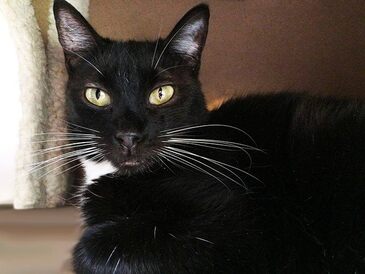
Why do cats have whiskers? For more reasons than they can count on one paw. Consider then, these seven scintillating snippets about a kitty’s wondrous whiskers.
1. They are especially sensitive: Since a cat’s whiskers are rooted more deeply in the skin than ordinary fur, the area around them has a very generous supply of blood and nerves. This makes the whiskers’ tips so sensitive that they can detect the slightest change in the direction of a breeze. On the downside, such hypersensitivity can actually cause your cat pain if you “toy” with them in any way. And because eating from a narrow bowl that presses on her whiskers can also be painful, try putting her food on a plate instead or buy her a wide, flat feeding bowl.
2. They aren’t only on her nose: Besides the eight to 12 whiskers your cat has on either side of her nose, she has shorter whiskers above her eyes, on her chin and on the backs of her lower front legs.
3. They help her figure out where she’ll fit: Because your cat’s whiskers are usually about as long as she is wide, they assist her in determining the width of various openings and whether or not she can safely and successfully slide her body through them.
4. They assist her in effectively hunting prey: Cats are farsighted (they don’t see well up close). This means that when they catch their prey, whether that prey is a live mouse or a favorite feather toy, they need a way to sense their prey is in the proper position for the “fatal” bite. Most crucial for this purpose are the whiskers on the backs of her forelegs and to a lesser degree, those on her chin and the sides of her nose.
5. They serve as an emotional barometer: The position of your cat’s whiskers can be an indicator of her mood. If her whiskers are relaxed and sticking out sideways, it means that she’s calm. If they’re pushed forward, it means that she’s alert and excited. If they’re flattened against her cheeks, it means that she’s angry or scared. But to confirm the message her whiskers are sending, examine the position of her ears and tail as well.
6. They should never be cut: While your cat sheds a few whiskers from time to time, you should never, ever trim them. She’ll become disoriented, dizzy and confused because she’s no longer receiving the vital navigational signals she needs. Imagine if you were suddenly blindfolded and unable to remove the blindfold for WEEKS! This is precisely how your kitty will feel if you cut her all-important whiskers.
7. They can change color: Don’t be surprised or alarmed if you discover a white whisker growing in your kitty’s otherwise solid black fur as she gets older. Like most people, cats will begin going gray with age, but it’s more noticeable in cats whose fur is a dark, solid color as opposed to patterned.









 RSS Feed
RSS Feed